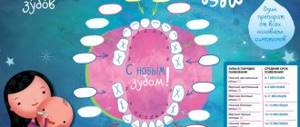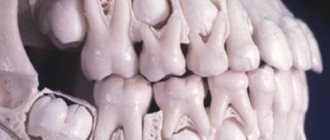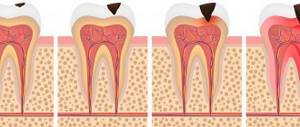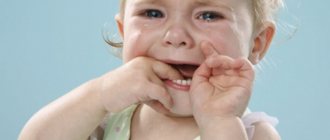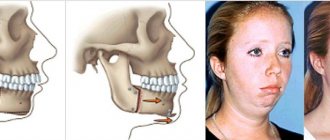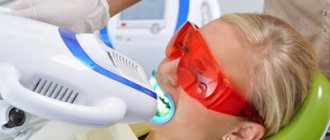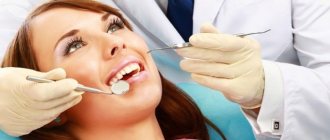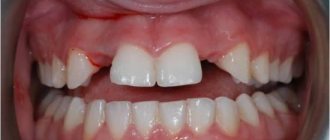Most children have their first teeth at 6-8 months. And when we see that a newborn baby has these “pearls” in his mouth, we are sincerely surprised. Indeed, the so-called natal teeth in newborns occur 1 time per 2-3 thousand crumbs. By the way, this phenomenon occurs much more often in girls than in boys.
Natal teeth are teeth that a baby develops in utero and are already present at birth. As a rule, parents observe two lower front teeth in the child’s mouth at birth. Neonatal teeth appear in a child in the first month of life.
Historians claim that Napoleon Bonaparte, Louis XIV, Julius Caesar, Charlemagne and other great people were born with natal teeth.
Are natural teeth dangerous?
In 95% of cases no. Natal and neonatal incisors are ordinary baby teeth that a child develops in the womb. The main feature of such teeth is that they usually fall out at 3-4 years.
However, natural teeth bring a lot of inconvenience to mother and child. Firstly, during feeding, the mother constantly experiences pain, because the baby unknowingly injures her nipples with his teeth. Secondly, the incisors damage the baby’s gums, frenulum and tongue. The baby develops cracks and ulcers in his mouth, the baby suffers, becomes capricious, and often cries. But, most importantly, if there are ulcers in the mouth, the child can easily get an infection on his own.
In approximately 5% of cases, natal teeth are additional. These supernumerary incisors form in the fetus on top of the baby tooth buds. This means that they will fall out very soon, leaving room for the incisors.
Timing of eruption
All children get their first teeth at different times. But already from the 1st month growth begins inside the gums. Teeth can come out early - at 3 months, or they can appear late - at 10-11 months. Most often, the first tooth can be seen at 6 months.
The early appearance of teeth in infants (3 months) is associated with the intake of vitamins and minerals during pregnancy. If teeth appear before 3 months, the child needs to be examined. This may be the cause of endocrine diseases.
Normally, by the age of one year there should be at least 1 tooth. In cases where the teeth do not come out for a long time, the child should be shown to a doctor to rule out developmental pathologies.
Reasons why babies teeth erupt late:
- rickets;
- weakened immune system;
- endocrine disorders;
- unbalanced diet, late complementary feeding;
- premature birth;
- edentia – absence of the rudiments of baby teeth.
The pattern by which the upper teeth erupt in most children is as follows:
| Name of teeth | Appearance time |
| Central incisors | 8–12 months |
| Lateral incisors | 9–13 months |
| Fangs | 16–22 months |
| First molars | 13–19 months |
| Second molars | 2–3 years |
The pattern of teething of the lower row of teeth in many children is as follows:
| Name of teeth | Appearance time |
| Central incisors | 6–10 months |
| Lateral incisors | 10–16 months |
| Fangs | 1.5–2 years |
| First molars | 1.5 years |
| Second molars | 2–3 years |
In some children, the pattern of teeth appearing changes, for example, the canines rather than the incisors emerge first. This is an individual feature that does not bring anything bad.
Consultation with a dentist is necessary when the pairing of eruption is disrupted: one tooth of the pair has appeared, but the other has not, while other teeth are being cut. This may indicate a congenital malformation.
Unpleasant symptoms and pain accompany the period when fangs come out. This is due to the fact that these teeth have sharp, wide and jagged edges.
The upper teeth are often accompanied by a runny nose. This occurs due to the spread of swelling and inflammation of the nasal mucosa. By the age of 3, babies should have 20 baby teeth.
Preventative dental checkups should not be ignored. First visit – at 1 year. Only a specialist can identify oral problems in a timely manner.
Why do natural teeth appear?
Most dentists associate the appearance of natal teeth with the processes that occurred during pregnancy:
- unbalanced nutrition when carrying a baby;
- superficial presence of rudiments in the fetus;
- infectious diseases of a pregnant woman with high fever;
- excess calcium and vitamin D;
- diseases of the endocrine system;
- long-term exposure to toxins;
- a woman taking illicit drugs in the first trimester of pregnancy;
- congenital pathologies of the fetus;
- unfavorable environment.
Natal teeth are diagnosed immediately at the birth of the child during an examination in the maternity hospital.
It has also been recorded that children are born with natal teeth suffering from the following pathologies:
- Ellis-Van Creveld syndrome. Genetic pathology of the fetus, which is characterized by growth retardation, disproportionate dwarfism and abnormal growth of all types of bone tissue.
- Hallerman-Streiff syndrome. Many anomalies that appear due to disturbances in the visceral mesoderm of the embryo. Dysmorphia of the maxillofacial part of the skeleton.
- Sotos syndrome. A congenital, sporadic disease in which the child grows very quickly. The pathology is also characterized by accelerated development of teeth.
- Craniofacial type of synostosis. Premature closure of cranial sutures, deformation and limitation of the volume of the skull.
- Multiple steatcystoma. A benign neoplasm characterized by multiple cystic nodules on the skin.
- Cleft in the sky. The palatal parts do not fuse, a congenital disease.
- Congenital pachyonychia. A genetic disease that affects the nail plates.
- Robin's syndrome. A disease characterized by underdevelopment of the mandibular bone, palatal clefts and recessed tongue.
Main reasons
Most of the reasons are not at all dangerous for the baby, although there are exceptions. They are usually associated with events that occur during the mother's pregnancy. The most common causes of this unusual phenomenon include the following.
- Poor, insufficient, unbalanced nutrition of the mother during pregnancy.
- The primary sources of teeth are located superficially.
- Severe infectious diseases of the expectant mother during gestation, which were accompanied by high fever.
- Exposure to certain types of toxins.
- Various congenital symptoms and diseases.
The doctor must find out the reason that caused the abnormal teething before the baby is born or during the first month of his life in order to decide on additional examination. This stage of diagnosis is very important in order to provide timely and high-quality help to the newborn child.
Classification
Natal and neonatal teeth were classified by Veronica Habling. The basis for the maturity of incisors is the quality of dental tissue, as well as the degree of its development.
Today there are four categories of natal elements:
- 1st category. The crown is shaped like a shell. The teeth have no roots, the incisors are barely fixed by the gums.
- 2nd category. Characterized by dense crowns and a very weak root structure. Often the roots of the teeth are completely absent, the tooth is weakly fixed in the alveolus.
- Category 3. The incisal edge of the tooth breaks through the gum slightly. The main part of the tooth is located inside the jaw bone.
- Category 4. The teeth can be easily felt, but are hidden by swollen tissues and are invisible to the eye.
Uneven gums in a child
Many parents, seeing that their child has uneven gums, worry whether the baby will grow crooked teeth. However, irregularly shaped gums are usually caused by an abnormal chin shape - a positional deformity of the chin.
This rare phenomenon is the result of pressure on the chin for a long time during fetal development. For example, a child's growing chin was located for a long time on his shoulder or on the mother's pelvic bone. This defect is similar to head deformities in newborns. The side of your baby's cheek that hasn't been pressed may appear fuller.
The good news is that chin positional deformity usually does not cause any consequences and is temporary. The chin almost always straightens on its own.
Diagnostics
As we have already said, diagnosis of natal teeth is carried out at the birth of the child. The doctor conducts a full clinical examination of the baby’s condition, evaluates the characteristics of the teeth and determines the cause of their appearance.
During the initial visual examination, the pediatrician assesses:
- mobility of incisors and their hardness;
- dental anatomy - matching the shape, color and size of the teeth;
- presence of root (if possible). If a tooth is mobile, most likely its root system is not developed or underdeveloped. It will most likely fall out on its own within a few weeks.
The doctor also conducts a mandatory examination of soft tissues:
- Examines the surface of the tongue and gum tissue. The pediatrician identifies the presence of granulomatous lesions and inflammation caused by irritation from the cutting edge of the tooth. If there is a risk of infection, the doctor advises not to save the incisors.
- Performs a general examination of the patient to exclude infections and other diseases. If necessary, the doctor prescribes a series of tests for the patient, recommends undergoing diagnostic examinations and obtaining consultations with specialists.
White dot on the gum of a child: Bohn's node
Many parents associate the appearance of a white dot on a child’s gum with teething. However, it is not.
The points are similar to a common, harmless phenomenon, which in medical parlance is called Bohn's nodes. About eighty percent of newborns have such gingival (gum) cysts, as they are also called. If they are located on the upper palate, then these are Epstein pearls.
It is not surprising that small white dots on a baby’s gums can be mistaken for teething. But these fluid-filled growths are milia—also known as infantile acne. Both papules and pearls usually gradually disappear on their own as the child grows.
Look at the photo of a white dot on a baby’s gum to get an idea of this phenomenon:
Indications for removal of natal teeth
Unusual early incisors should be removed if the doctor notices:
- The edges of the teeth are too sharp;
- Significant mobility of teeth (absence and underdevelopment of roots);
- Weakened incisor structure;
- Thin, discolored tooth enamel;
- Irregular shape of “pearls”.
If natal teeth have at least one of the problems listed above, they can injure the soft tissues of the oral cavity and mucous membranes. Moreover, teeth with weak roots can fall out at any time and fall into the respiratory tract, which is dangerous for the baby’s life.
Functions of a child's gums
Compared to other parts of the mouth, a baby's gums usually cause the least amount of concern for parents. But their importance cannot be underestimated. It is with the help of the gums that the baby holds the mother's nipple or pacifier. And thanks to the gums (and bones), the child’s teeth stay in place.
The gums have a hard time : in infancy, many functions fall on them, which will later be transferred to the teeth, because it is with the help of the gums that babies chew food. Gums are exposed to food, liquids, bacteria and sharp objects.
The appearance of the gums can provide useful information about how the baby’s intrauterine development occurred, what the child’s current state of health is, and what the baby may expect in the future.
Preservation of teeth
Most often, natal teeth do not have any negative consequences for the child. The baby was just born special. If the parents and the doctor decide to preserve the incisors, it is worthwhile to be attentive to his oral cavity from the very first day of the child’s life.
Early teeth, much more than baby teeth, require careful care and attention. The child should be regularly shown to the dentist to have the oral cavity cleaned of bacteria.
An ideal care product and method for massaging fragile children's gums and, accordingly, natal teeth are Asepta Baby wet wipes, intended for children from 0 to 3 years old. Finger wipes prevent the growth of bacteria in the oral cavity, reduce discomfort during the eruption of subsequent baby teeth and perfectly clean all surfaces of the oral cavity.
So, now you know how to take care of a baby who was born with teeth. Don’t forget that there is a popular saying: if a child is born with incisors, a happy, rich life awaits him. The baby will grow up brave and strong, and will always be able to stand up for himself!
Doctors' opinions and forecasts
In most cases, no unpleasant consequences are expected in the future for a baby born with teeth. If the teeth have not been removed, proper care and timely visits to the dentist are important.
In cases where teeth have been removed, observation by an orthodontist is also important to monitor the formation of the correct bite in the child.
If these simple rules are followed, a child born with teeth will be no different from other children.
Experts' opinion
The ASEPTA series of products is characterized by clinically proven effectiveness. The results of studies of toothpastes, napkins, rinses, balms and other ASEPTA products are regularly published on our website. The effect of the products produced is tested in our own laboratory at the VERTEX research center. All products have certificates of conformity.
The active components of the wipes are:
- Xylitol. Clears plaque and prevents the occurrence of caries.
- Calcium pantothenate. Promotes the formation of strong tooth enamel
- Chamomile, witch hazel and green tea extract. They have an anti-inflammatory effect, help relieve swelling and discomfort during teething.
Napkins have:
- Certificate of Conformity No. ROSS RU.AG81.N01070;
- Certificate of Conformity No. ROSS KR.AG81.H01815;
- Certificate of state registration No.RU.47.01.05.014.E.000002.01.18.
Sources:
- Report on determining/confirming the preventive properties of toothpaste “ASEPTA PLUS” GENTLE WHITENING” Author: doctor-researcher A.A. Leontyev, head Department of Preventive Dentistry, Doctor of Medical Sciences, Professor S.B. Ulitovsky First St. Petersburg State Medical University named after. acad. I.P. Pavlova, Department of Preventive Dentistry
- Report on the determination/confirmation of the preventive properties of personal oral hygiene products “ASEPTA PLUS” Remineralization doctor-researcher A.A. Leontyev, head Department of Preventive Dentistry, Doctor of Medical Sciences, Professor S.B. Ulitovsky First St. Petersburg State Medical University named after. acad. I.P. Pavlova, Department of Preventive Dentistry
- Clinical experience in using the Asepta series of products Fuchs Elena Ivanovna Assistant of the Department of Therapeutic and Pediatric Dentistry State Budgetary Educational Institution of Higher Professional Education Ryazan State Medical University named after Academician I.P. Pavlova of the Ministry of Health and Social Development of the Russian Federation (GBOU VPO RyazSMU Ministry of Health and Social Development of Russia)
What to expect
The first teeth appear at about 6 months of age. It may take 2 months from the moment the first signs appear until the tooth appears.
The following symptoms will help you understand that your baby is teething:
- before the teeth emerge, the gums look inflamed and swollen;
- salivation increases;
- the child begins to put all objects and toys into his mouth;
- eats poorly;
- sleep becomes interrupted, often wakes up crying.
The baby's behavior during teething also undergoes changes. The baby becomes capricious, excitable, and often asks to be held.
Does not tolerate harsh sounds or bright light. There are sudden changes in mood: from apathy to an increased desire to be paid attention to.
Signs of teething that resemble the onset of a cold and bowel dysfunction:
- frequent regurgitation;
- the temperature rises to 38 degrees;
- bowel disorder (constipation or diarrhea);
- runny nose;
- cough;
- rash on cheeks.
It is not necessary that all these symptoms will be detected immediately. Some babies may only experience diarrhea, while others may simply drool. When the upper teeth come in, the temperature often rises.
During teething, especially the upper ones, the gums are injured. Therefore, you can see blood on it. It can change the smell of your mouth.


